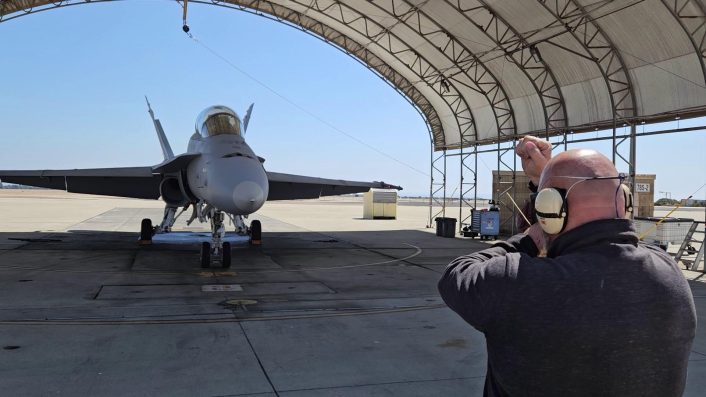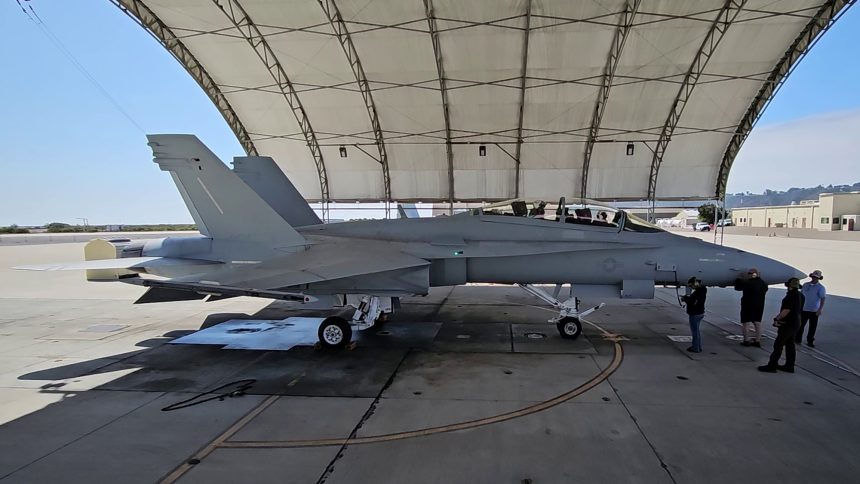FRCSW managed to push the Legacy F/A-18’s service hours well beyond its original 6,000-flight-hour expectation, with some even exceeding 9,000 hours.
Fleet Readiness Center Southwest (FRCSW), at NAS North Island, San Diego, California, has been a vital part of naval aviation upkeep since it began operations in 1919. Over time, the center has been key to ensuring the readiness of the U.S. Navy, keeping famous aircraft such as the F-14 Tomcat, A-6 Intruder, and S-3 Viking operational. The FRCSW marked a significant change as it completed the final maintenance on its last older-generation aircraft—an F/A-18 Hornet, recently.
First deployed in the 1980s, the F/A-18 Hornet has been a highly adaptable and crucial part of naval air power, active in major military operations including Operation Desert Storm and the Kosovo War. The Hornet in question, known as AQ-99, carries a storied past, symbolizing not just its role in combat but also FRCSW’s legacy of aircraft servicing. “This is a big moment for the depot,” said Ehren Terbeek, the center’s Tactical Air Program Manager in a public statement. “Many of our team members began their careers working on these planes, so this milestone resonates deeply.”
The center’s contributions to the lifespan of these aircraft have been remarkable. Through strategies like replacing the center barrel, FRCSW managed to push the F/A-18’s service hours well beyond its original 6,000-flight-hour expectation, with some even exceeding 9,000 hours. Terbeek noted:
“The aircraft’s age made finding parts difficult, and structural repairs were challenging, but the team’s expertise kept these jets flying.” This dedication has played a crucial role in maintaining the operational capabilities of naval aviation for years.
FRCSW’s workforce, many of whom are military veterans, take great pride in their roles. The recent departure of the penultimate Hornet to Fort Worth, Texas, and now the final one returning to Miramar, holds a mix of emotions for those who spent years ensuring these jets were ready for action. For numerous team members, working on the F/A-18 has been a defining part of their professional lives.
“It felt bittersweet to see an aircraft go that represented so much of our work,” Terbeek.
As FRCSW shifts its focus to newer platforms like the F-35 and unmanned systems, the lessons learned from years of servicing older aircraft will guide its future work. Completing this final maintenance project on the F/A-18 Hornet represents the close of one chapter while paying homage to the center’s storied past and the skilled teams that sustained its success.
Fleet Readiness Center Southwest remains the top West Coast facility for the repair, upkeep, and overhaul of Navy and Marine Corps aircraft and their systems.

FRCSW
Here’s the mission of the FRCSW as described on the U.S. Navy’s official website:
FRCSW provides the full spectrum of maintenance, repair and overhaul (MRO) services to all seven variants of the F/A-18 Hornet fighter, our nation’s first aircraft designed as a dual role attack-fighter aircraft.
Since its production in the early 1980s and maiden combat mission in 1986 against Libyan forces, seven variants of the twin-engine airframe have served the Navy and Marine Corps. Today: the legacy A-D, the E/F Super Hornet and the EA-18G Growler, an airborne electronic attack aircraft are the primary aircraft fighters.
To prolong the service life of the legacy Hornets, FRCSW developed the Center Barrel Plus (CBR+) program from a procedure it created in 1991 to replace the center fuselage section of a relatively new Hornet which had crashed.
The CBR+ program addresses the high-flight-hour fatigue of the airframe and includes replacement of the aircraft’s forward and aft dorsal decks, and the forward, aft, and keel longerons (structural beams).
To date, FRCSW has completed more than 100 CBR+ procedures.
For the remaining F/A-18 variants, the command conducts two scheduled maintenance events. The first is an assessment of the major components like engines, rudders and stabilizers, and the second includes a corrosion inspection, testing of the transmissions and structure integrity of the aircraft.
FRCSW also performs modifications to the airframe that upgrade its operating or weapons systems.
Along with the FRCSW, other Fleet Readiness Centers across the U.S. provide maintenance, repair, and overhaul services for the F/A-18C/D/E/F as well as the rest of the U.S. Navy fleet aircraft. These include:
- Fleet Readiness Center Southeast (FRCSE): Located in Jacksonville, Florida, FRCSE supports the maintenance and overhaul of various Navy and Marine Corps aircraft, including the F/A-18 Hornet and Super Hornet.
- Fleet Readiness Center East (FRCE): based at Marine Corps Air Station (MCAS) Cherry Point in North Carolina, FRCE is known for its comprehensive maintenance work on fixed-wing aircraft, including the F/A-18. The unit recently delivered the final AV-8B Harrier to the fleet.
- Fleet Readiness Center West (FRCW): located at Naval Air Station Lemoore, California, FRCW is particularly focused on maintaining and supporting the F/A-18 Super Hornet fleet, as NAS Lemoore is a key base for these aircraft.









